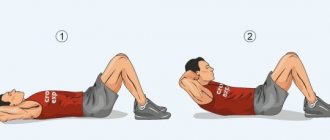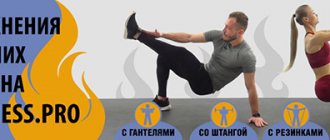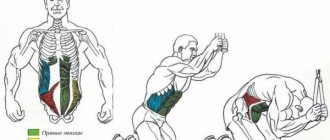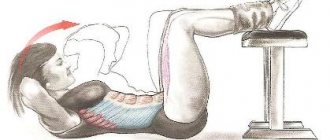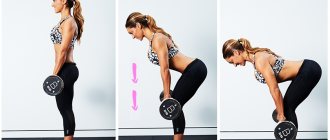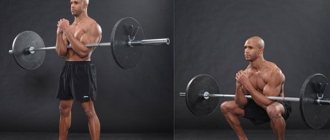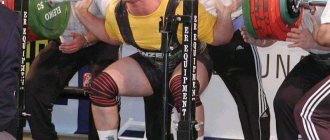Benefits of Exercise
A fitball is a gymnastic ball with a diameter of 55-75 cm. It is made of synthetic material and is used in the comprehensive development of human muscles. Crunches with a similar ball have the following advantages:
- They use several muscle groups at once, therefore they help strengthen the lower and middle back;
- create a static load while maintaining balance, which allows you to strengthen deep stabilizing muscles, tighten your hips and buttocks;
- allow you to work the rectus muscle in isolation and strengthen your abs;
- develop balance and stabilization, since when performing the exercise it is necessary to synchronize movements and strain coordination;
- practically harmless, since the risk of injury is reduced to zero, and the ball is easy to inflate and deflate;
- can be practiced by everyone, since there are no restrictions on age and level of physical fitness.
Thanks to regular exercises on a fitball, it will be possible to improve blood flow in the lower zone, as well as remove traces of cellulite due to prolonged retention of tension.
Twisting (crunches): video
Twisting, also called crunches, are exercises aimed at reducing the gap between the chin and the pelvis when bending the back in the spine.
These are the best exercises for working all abdominal muscle groups. Their correct and systematic implementation leads to the appearance of six-pack abs that everyone desires. The effectiveness of these exercises is achieved through powerful contractions of the abdominal muscles. If you do crunches at a fast pace, then the formation of a metabolic press gradually occurs, which activates the resorption of fats deposited in specific areas of the abdomen. Over time, fat deposits are reduced, the stomach is tightened and muscle relief, which is commonly called cubes, begins to appear. An example of performing crunches on a fitball is shown in the illustration.
Crunches help tone not only the abdominal muscles, but also the tissues of the body, which helps strengthen them and prepare them for powerful physical activity. During the exercise, blood flow accelerates and the blood reaches deep-lying muscles and even the spinal region. And this is important for accelerating the transfer of nutrients throughout the body in order to maintain health at the proper level.
Ab crunches have huge health benefits. It not only helps to cope with excess fat and create abdominal relief, but also includes all the muscles of the abs, hips, buttocks and back. Thanks to this, the lower vertebral part is strengthened and fixed, which leads to the formation of correct posture. With the development of the abdominal muscles, the torso becomes more mobile, and discomfort when moving in different directions is eliminated.
This video tutorial presents a set of crunches for working the abdominal muscles of women. Remember that the main rule of any workout is regularity. If you want to perfectly work out your abdominal muscles, burn extra calories and eliminate fat deposits, then you should develop a training program taking into account individual characteristics, nutritional diet, and health status.
Execution technique
Classic crunches on a fitball are done in this order:
- Take the starting position - lying on the ball. To do this, sit on the ball and slowly slide down, moving your legs forward. You need to stop when the shoulder blades land on the projectile. In this case, you need to press your back against the ball so that the curve of the lumbar region is clearly visible.
- Bend your legs at the knees, spread them wide and place your feet on the floor. You can hold your arms in two ways - crossed over your chest or placed along your body. This arrangement will help prevent neck overload. Advanced athletes can join their hands at the back of the head, since in this case the load increases by 1.5 times.
- Lower the upper point of the body until you feel severe pain in the abdominal muscles. At the same time, it is strictly forbidden to move your neck.
- As you exit, pull your shoulders forward toward your waist, keeping your hips still and focusing on your abdominal muscles. This movement is a twist, causing tension and compression of the abs. It is strictly forbidden to expose your lower back to the ball.
- At the top point, hold for 2 seconds and tense your abdominal muscles as much as possible. In this case, discomfort will be felt in the abdominal area.
- While inhaling, return to the starting position.
You can clearly see the classic technique below:
How to perform exercise
- Lie on an exercise ball with your lower back curvature pressed against the spherical surface of the ball. Your feet should be bent at the knee and pressed firmly against the floor. The upper torso should be hanging off the top of the ball. The arms should either be kept alongside the body or crossed on top of your chest as these positions avoid neck strains (as opposed to the hands behind the back of the head position).
- Lower your torso into a stretch position keeping the neck stationary at all times. This will be your starting position.
- With the hips stationary, flex the waist by contracting the abdominals and curl the shoulders and trunk upward until you feel a nice contraction on your abdominals. The arms should simply slide up the side of your legs if you have them at the side or just stay on top of your chest if you have them crossed. The lower back should always stay in contact with the ball. Exhale as you perform this movement and hold the contraction for a second.
- As you inhale, go back to the starting position.
- Repeat for the recommended amount of repetitions.
Caution: Perform this exercise slowly and deliberately as it takes some getting used to. Also, do not be hasty and try to use weights on the first time; you'll have enough on your hands learning how to balance yourself. Also, if balance is an issue I recommend having a spotter next to you and also placing each of your feet under a 100-lb dumbbell for added stability. As you get more advanced you can hold a dumbbell or a weight plate (held at arms length) on top of your chest. However, you have to be very careful when adding weight to this exercise, because if you add too much too quickly you could get a hernia.
Variations: You can perform this exercise with a low pulley behind you with a rope attached on its end. In this manner you can go ahead and add resistance easier. For this variation, you will need to hold on to the sides of the rope throughout the movement. I like to bring my arms forward to the point that the upper arms are almost parallel to my torso and the lower arms are facing back holding the rope.
Adviсe
To properly perform crunches on a fitball, you should take the following tips into account:
- lift the body smoothly without the help of hands and with the effort of the abdominal muscles;
- round your shoulder blades to tighten your back, focusing tension in the center of your abs and indirectly not engaging other areas;
- do not lift your lower back from the fitball throughout the entire curl;
- spread your legs wide for better balance;
- stretch the entire back area on a fitball;
- do not throw your head back when twisting;
- bend forward quickly, but return to the ball more slowly;
- if you cannot maintain balance when twisting, at the initial stages you can rest your feet against the wall;
- when exerting force (twisting), exhale, and when relaxing and returning to the starting position, inhale;
- when mastering the technique, you should keep your arms along your body, and if you cannot maintain balance, cross them over your chest;
- as you become more trained, your arms should be fixed above your head;
- To increase the effectiveness of crunches, you should perform them with additional weight, for example, with weights or dumbbells in your hands, which you need to hold on your chest.
Contraindications
Like any physical activity, crunches have certain limitations due to the health status of the trainee.
Twisting is contraindicated in the following cases:
- Presence of hernias.
- Disturbances in the functioning of the cardiovascular system.
- Musculoskeletal diseases.
- Kidney diseases.
- Disturbances in the respiratory system.
- Adhesive disease.
- Rheumatism.
- Serious gastrointestinal diseases.
- Postoperative period.
- Presence of injuries.
Only in consultation with your doctor is it permissible to perform twisting exercises.
Basic mistakes
Beginners often make the following mistakes:
- Excessively lowering the pelvis . When the pelvis is strongly lowered down during twisting, the load on the abdominal muscles is significantly reduced, which reduces the quality of the exercise.
- They disrupt the breathing rhythm . Incorrect inhalation and exhalation will reduce endurance, so you may not complete all the sets planned for training.
- Raise the body by flexing the hip joint . This reduces the load on the abdominal muscles.
These mistakes should not be made under any circumstances, regardless of the version in which crunches are performed on a fitball.
results
For all exercises tested, Francis also found that positive contractions produced more muscle work than negative contractions. Many people are concerned about eliminating the hip flexors when working on the abs, but Francis says that this is anatomically impossible. “The hip flexors, obliques and abdominal muscles are synergistic; they work as a team, and you can't use one without also using the other,” he states.
Although they are technically separate muscle groups, the abdominal muscles work together to enable you to run, jump, and more. Knowing this, try a new approach to abdominal training: Instead of thinking about which exercise hits which part of the abs, focus on developing the abdominal region as a whole for a stunning look.
Variations
After mastering the classic technique of twisting on a ball, you can move on to performing various variations of this exercise.
With your feet up
Performed in this order:
- Lie on the mat with your back and grab the ball with your feet. Legs can be bent at the knees or kept straight. The best option is to alternate both positions.
- Place your arms along your body, palms down.
- Tighten your abdominal muscles, stretch your shoulders towards your knees.
- Slowly return to the starting position, and do not lower your feet to the floor, but keep the ball suspended with them.
Perform the exercise until you feel a burning sensation in your stomach, and then rest for half a minute and repeat 2 more times.
Russian twist
The exercise is complicated by turning the body, which allows you to additionally work the oblique muscles. The Russian twist is made in this order:
- Take the classic starting position, but extend your arms in front of you and join your palms.
- With an exhalation, lift your back off the floor and turn your body to the left side, where you point your outstretched arms.
- Inhale and return to the starting point. Do the same thing, but to the right.
It is recommended to perform 15 repetitions on each side during the workout.
To increase the load on the middle zone of the body, you should not lower your shoulder blades onto the fitball.
Oblique crunches
Such exercises also help to work the lateral abdominal muscles. They need to be done as follows:
- Lie on the ball with your left side.
- Place the arch of your left foot on the floor, bring your right foot forward and step on the floor with the entire sole. To maintain balance with crossed legs, the exercise should be done against a wall.
- Move your right hand to the back of your head, and keep your head in line with your body.
- Tear off the top of the body and bend towards the waist.
- At the point of maximum bending, linger for 3 seconds and return to the starting position.
Oblique twists should be performed 15 times on each side.
Video instructions will help you master lateral twists:
Science and the "six pack"
Although it is impossible to separate the abs , you can choose the right exercises, since the differences between them are quite significant. In a recent study conducted at the University of San Diego, California, 31 people were tested using an electromyograph. Electrodes were attached to the top and bottom of the rectus abdominis, as well as the top of the obliques and hip flexors. As muscles contract, they send electrical impulses that are read by electrodes and processed by a computer, explains Dr. Peter Francis, director of the biomechanical laboratory and leader of the study. “This data tells us which exercise makes which region work harder.”
Volunteers performed 14 repetitions of 13 different exercises. The result was hundreds of crunches. While all of the exercises required significant work from the rectus abdominis (good news for those aiming for a six-pack), three exercises outperformed the others in recruiting the abdominal muscles: hanging leg raises, bicycle crunches, and reverse crunches . “All of these exercises put the pelvis in an unstable position, forcing all the abdominal muscles to work for stabilization,” says Francis—this happens in a hanging position, or when you lift your legs or pelvis from the floor. Add to this the twisting of the body - and you will develop even greater muscle activity, involving the oblique abdominal muscles in the work.”
Lesson scheme
It is recommended to perform twisting 12-15 times in 3 approaches. Between sets you need to take a short break of a minute. In total, you should perform from 36 to 45 repetitions per workout.
It is very important not to neglect warming up. So, the lesson should start with running in place, body turns, arm swings and squats. After performing crunches, it is worth setting aside 2-3 minutes for stretching, which can be done directly on the fitball. So, you need to stay in the starting position, stretch your arms back, stretch your feet and palms in opposite directions. Hold the pose for about a minute, and then relax and perform a couple more approaches.
During exercise, you should maintain the same pauses and pace of exercise to get the maximum benefit from crunches.
Crunches on a fitball are effective exercises for training the abs, which are an alternative to classic crunches on the floor. Their advantage is that the back and lower back receive soft support. Of course, you will need to learn how to maintain balance so as not to fall off the ball and get injured.
Plan of attack
Time for crunches: Choose three or four of the suggested exercises and perform them in a circuit. Do 10-20 controlled reps of each without resting between sets. Repeat the entire circle two to three times. This type of training should be repeated no more than three times a week, meaning at least 48 hours should pass between sessions.
Little, but regularly: If you prefer to train your abs every day, choose one of the exercises described and perform it in three to four sets of 15-20 slow repetitions in one session. Next time, try another exercise. Work in strict form and remember to breathe.
You'll probably want to pick the top three exercises, but Dr. Francis argues against that. “Consistently alternating exercises and using different techniques will work best for your abs,” he says. “Beginners need to gradually master the first three exercises on the list, as they are very difficult even for experienced athletes.”
Regardless of the choice of exercise, go up for four counts, go down for two.
Exercise substitutions
You can try replacing the exercise “Exercise Ball Crunch” with one of these exercises. The possibility of replacement is determined on the basis of the muscle groups involved.
Weighted Ball Side Bend Crunches Cable Crunch Hanging Leg Raise Hanging Pike Decline Crunch Weighted Crunches Reverse Crunch Cable Seated Crunch Knee/Hip Raise On Parallel Bars Exercise Ball Crunch Author: AtletIQ: on Exercise Ball Crunch — The benefits of exercise, how to properly perform and how many sets to do.. Rating: 5

